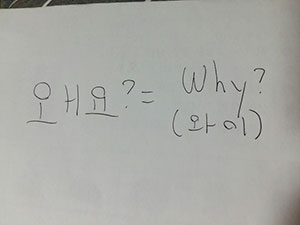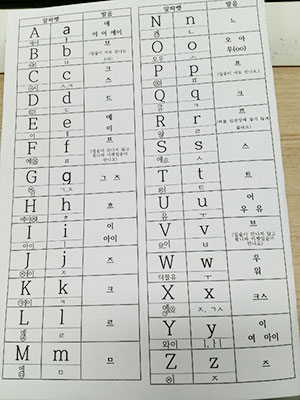
-
Teaching Students with Disabilities Pre and Post COVID-19
Grant Everett
 During the EPIK orientation we were prepared for many different situations such as how to teach students with varying skill levels, how to make our lessons fun and engaging, and how to get along with our co-teachers. However, what I wasn’t prepared for was a little boy in my 3rd grade class with autism, and another boy in my 4th grade class who had severe hearing loss in both ears. The student with autism would sometimes be accompanied by the special needs teacher, but sometimes he would be alone. Occasionally he would scream loudly, or chase after some of the female students. He would have moments where he would repeat himself, or stand on the chair. When COVID-19 started he had a difficult time keeping his mask on, and was more frustrated than usual. I started talking with the special-needs teacher during lunch to figure out more about this student and how to establish a rapport with him. I learned that he could focus on speaking some English words, but struggled with writing. I learned that he loved music and that hidden picture worksheets could help him when he loses focus. He still has his off days, as we all do, but by understanding him more I’ve become more patient with him. I’ve also learned that distracting him by pointing to things in the textbook can be another way to get him back on track.
During the EPIK orientation we were prepared for many different situations such as how to teach students with varying skill levels, how to make our lessons fun and engaging, and how to get along with our co-teachers. However, what I wasn’t prepared for was a little boy in my 3rd grade class with autism, and another boy in my 4th grade class who had severe hearing loss in both ears. The student with autism would sometimes be accompanied by the special needs teacher, but sometimes he would be alone. Occasionally he would scream loudly, or chase after some of the female students. He would have moments where he would repeat himself, or stand on the chair. When COVID-19 started he had a difficult time keeping his mask on, and was more frustrated than usual. I started talking with the special-needs teacher during lunch to figure out more about this student and how to establish a rapport with him. I learned that he could focus on speaking some English words, but struggled with writing. I learned that he loved music and that hidden picture worksheets could help him when he loses focus. He still has his off days, as we all do, but by understanding him more I’ve become more patient with him. I’ve also learned that distracting him by pointing to things in the textbook can be another way to get him back on track.
 I’ve taught the second student with a hearing disability for about two years until he graduated last year. I noticed he had hearing aids in both ears, would speak loudly, and didn’t have clear pronunciation when he was speaking in Korean. He didn’t have much interest in English, and wouldn’t participate in class. My co-teachers were usually too busy to give him the one on one attention that he needed, so I took it upon myself to find a way to connect with him. I tried using Korean sign language, but he didn’t know it. I tried mouthing the words, but he would just ignore me. Later, when we were doing a writing activity, I asked him to try to write one word. He asked me “Why?” in Korean. I had an idea. He wasn’t confident speaking English, but he could speak Korean, so I wrote the English pronunciation phonetically in Korean. I wrote down “why” with the Korean pronunciation on his white board. He looked at me slightly confused and said in English “Why?” I was so happy. It was the first time I’ve heard him speak English. He didn’t approve of my happiness and said in Korean “I don’t want to!”, so I showed him how to say that in English, too. I was so happy to finally figure out a way to teach him before he graduated.
I’ve taught the second student with a hearing disability for about two years until he graduated last year. I noticed he had hearing aids in both ears, would speak loudly, and didn’t have clear pronunciation when he was speaking in Korean. He didn’t have much interest in English, and wouldn’t participate in class. My co-teachers were usually too busy to give him the one on one attention that he needed, so I took it upon myself to find a way to connect with him. I tried using Korean sign language, but he didn’t know it. I tried mouthing the words, but he would just ignore me. Later, when we were doing a writing activity, I asked him to try to write one word. He asked me “Why?” in Korean. I had an idea. He wasn’t confident speaking English, but he could speak Korean, so I wrote the English pronunciation phonetically in Korean. I wrote down “why” with the Korean pronunciation on his white board. He looked at me slightly confused and said in English “Why?” I was so happy. It was the first time I’ve heard him speak English. He didn’t approve of my happiness and said in Korean “I don’t want to!”, so I showed him how to say that in English, too. I was so happy to finally figure out a way to teach him before he graduated.
It was time to finish class, and I noticed him copying down what he wrote on the whiteboard. It wasn’t always simple, and he didn’t always want to participate, but I wanted to show him that it was possible. Before he graduated I gave him a sheet of paper with the alphabet that had instructions written phonetically in Korean that another teacher made. After COVID-19 hit, many students who have hearing disabilities faced another obstacle to get over. Wearing a mask presents another challenge for students with hearing disabilities who communicate via lip reading. These students are at risk of falling drastically behind their peers. Writing things down with visual aids can be a way to give them more support. We can also try to add specific gestures to words to help convey the meaning. Another important tip is to understand which ear has the most trouble. Hearing may not be the same in both ears. By knowing this, we can help avoid misunderstandings in the future.
I’m afraid that some of my students might fall through the cracks because they aren’t getting the support that they need in class. Our co-teachers are human, too, and they may not have the time and energy to address those specific needs. It may feel like an uphill battle, but by understanding our students we can design lesson plans that better suit their needs. We can’t make up for lost time, but by showing our students that we care about them and that we won’t give up on them, they in turn might start to believe in themselves as well.
English Program in Korea(EPIK), Teach and Learn in Korea(TaLK)
National Institute for International Education Ministry of Education, Republic of Korea
191, Jeongjail-ro, Bundang-gu, Seongnam-si, Gyeonggi-do, Republic of Korea (zip code) 13557 Tel : +82-2-3668-1400 Fax: +82-2-764-1328
National Institute for International Education Ministry of Education, Republic of Korea
191, Jeongjail-ro, Bundang-gu, Seongnam-si, Gyeonggi-do, Republic of Korea (zip code) 13557 Tel : +82-2-3668-1400 Fax: +82-2-764-1328


